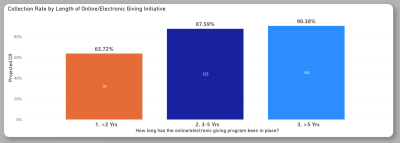How Electronic Giving Helps Churches Fulfill Their Mission
By Alison Burdett
When giving depends on who makes it to church on Sunday, the offering can fluctuate with the weather, vacation schedules, or even a bad cold. Checks stay on kitchen counters, plans get delayed, and budgets feel the strain. But for churches with electronic giving, generosity doesn’t pause when attendance does. That steady stream of giving helps congregations stay current on their mission shares and keeps ministries strong, week after week.
That’s one of the key stories emerging from a recent midyear financial survey of Baltimore-Washington Conference (BWC) churches, conducted in July by John Gauthier, the conference’s data analyst and applications administrator.
Of the 553 churches in the BWC, 407 responded to the survey. At least 288 of those churches, about 52 percent of all churches in the conference, have already adopted some form of electronic giving. And many have been using it for quite some time: roughly a quarter (26 percent) report offering online giving for more than five years.
 The survey’s early analysis suggests a strong connection between online giving and improved mission share collections. Churches that have added electronic giving in the past two years are projecting to reach about 63 percent of their mission share goal for 2025. Those that have had e-giving in place longer are performing even better, with churches that have used it for three to five years reaching about 87 percent of their goal, and those using electronic giving for more than five years reaching about 90 percent of their mission share goal.
The survey’s early analysis suggests a strong connection between online giving and improved mission share collections. Churches that have added electronic giving in the past two years are projecting to reach about 63 percent of their mission share goal for 2025. Those that have had e-giving in place longer are performing even better, with churches that have used it for three to five years reaching about 87 percent of their goal, and those using electronic giving for more than five years reaching about 90 percent of their mission share goal.
“The suggestion from this is that the collection rate for churches is better the longer they’ve had online giving,” Gauthier explains. Electronic giving doesn’t create generosity out of nowhere, he adds, “but it makes it easier for people to follow through on the generosity they already intend.”
That steadier, more reliable income stream helps churches stay current on their mission shares and other financial obligations, and it strengthens the connectional ministries those mission shares support across the conference and around the world.
For local churches, the most significant benefit Gauthier sees is stability. When givers enroll in recurring electronic giving, they don’t have to remember their checkbook, and their giving doesn’t disappear when they’re traveling, sick, or kept home by bad weather.
“Predominantly, it allows churches to plan better; it allows them to budget,” Gauthier says. “They can know they’ll be able to pay for something in the future, even if they don’t have all the funds on hand right now.”
Electronic giving reduces the month-to-month volatility that many finance committees are all too familiar with and lowers the stress that comes with income fluctuations from week to week.
For some congregations, the biggest barrier to electronic giving isn’t theology or conviction; it’s fear that it will be complicated or confusing. Gauthier pushes back on that assumption.
“It’s incredibly easy to set up and incredibly easy to use,” he says. Churches can offer giving options through QR codes in bulletins, text-to-give services, web forms, and even kiosks where people can tap their card or phone.
These options make it possible to receive offerings not only on Sunday mornings but also at retreats, special events, and community gatherings where people may not have cash or checks with them.
Yes, there are transaction fees. But churches that have adopted electronic giving consistently report that the benefits far outweigh the costs. Gauthier notes that he’s not aware of any BWC churches that started using online giving and then stopped, not because of fees or for any other reason.
The United Methodist General Council on Finance and Administration (GCFA) endorses Vanco as a primary provider of electronic giving solutions, and many BWC congregations are using Vanco and other trusted platforms with good results.
Local church leaders who want to learn more can start by exploring the electronic giving resources on the BWC website, which offer practical tools and links for getting started.
Gauthier’s hope is that more congregations will see electronic giving not as a technical upgrade, but as a ministry tool, one that supports discipleship, strengthens mission share faithfulness, and helps pastors and finance teams focus less on financial anxiety and more on making disciples of Jesus Christ for the transformation of the world.
